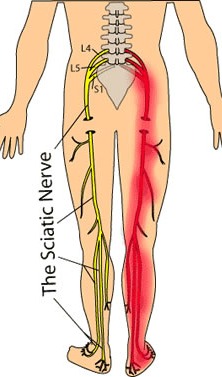Sciatica is pain, numbness or tingling that is felt in the butt or back of the leg cause by issues in the lumbar nerves. Initially it may be difficult for someone to recognize the cause of this pain as the symptoms can be felt far from the source of the pain (low back). For some individuals the sciatic pain will develop very gradually. Sciatica is irritation or compression of spinal nerve roots that make up the base of the large sciatic nerve. This compression or irritation sciatic nerves can be present on the left, right or both legs. Symptoms sometimes include localized low back pain at the source of the inflammation. Sciatica often including numbness or weakness in the leg – in extreme cases this extends to the feet and toes. The location of the pain (and specific symptoms) can often be used to trace back to where the sciatic nerve is being irritated.
The Sciatic Nerve is the largest nerve in the body. There are two identical Sciatic nerves on both sides of the body passing down the left and right legs. These nerves originate from five nerves of the lower spine (L4, L5, S1, S2 and S3) and merge into a single large nerve that passes through the pelvis (Sciatic Foramen) and runs down to the back of the knee where it branches into smaller nerves that continue down to the feet.

Sciatica is often caused from bulging or ruptured spinal discs. Other conditions that cause sciatica are spinal stenosis, arthritis, bone spurs, or nerve root compression/pinching caused by injury. Pregnancy can also cause sciatica in a small percentage of women.
If you are suffering a loss of strength in your foot or leg (due to sciatic issues), seek immediate medical attention. It is likely that your nerve is being impinged by your spinal disk (which may or may not be causing lower right back pain) and the sooner the problem is fixed the less likely (or less sever the permanent damage will be.
Suffers of sciatic pain may notice an increase in pain from sitting or standing for prolonged periods, while sleeping, sneezing, or bending forward.
There are some tests and symptoms can determine what vertebrae/nerve is being impinged:
– Impingement at L4 typically causes a reduced knee-jerk reaction
– Impingement at L5 Typically causes numbness in the big toe or top of the of foot
– Impingement at S1 may notice reduced ankle jerk reaction or weakness in the calf
